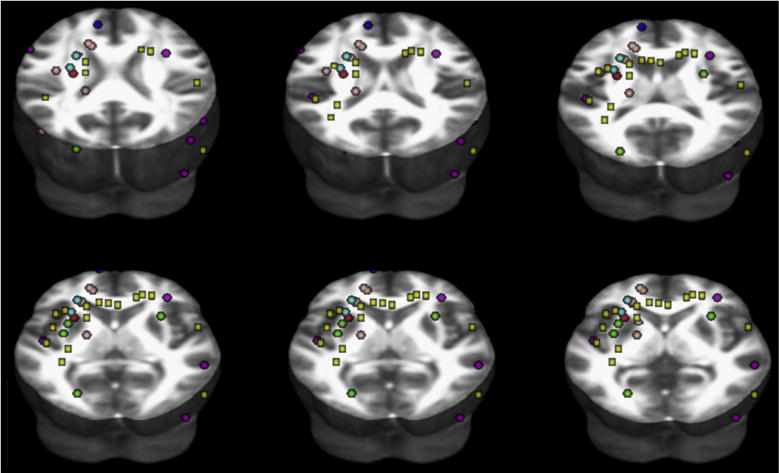Fig. 1.

Map of coordinates in Montreal Neurological Institute space of significant findings of FA reductions in subjects with dyslexia compared to normal readers, as reviewed across DTI studies. We performed an online search in the database PUBMED from January 1996 to February 2011, using the keywords “diffusion tensor” and “developmental dyslexia”. We then checked the references lists for DTI additional studies. We included studies that reported (1) a minimum of six directions (2) anisotropy-based statistical comparisons between subjects with dyslexia and normal readers (3) stereotactic coordinates of FA whole-brain results (4) thresholds for significance, i.e., corrected for multiple comparisons or uncorrected with spatial extent thresholds. We also included one study that employed Tract-Based Spatial Statistics (Richards et al., 2008), and one that applied a priori defined anatomical regions of interest (Niogi & McCandliss, 2006). Six studies were included (Table 1). From each cluster of significant differences, we selected the millimetre-space coordinates of the voxel where the difference between subjects with dyslexia and normal readers was maximum. Coordinates reported in Talairach space were converted to Montreal Neurological Institute space. Spherical regions of interest (2 mm radius; see colours in Table 1) were then created and centred at the peak coordinates reported for each study. Yellow box regions of interest were instead created and centred at the coordinates reported in Table 4A (FA differences between DYS+ and NR− in our study). Finally, all regions of interest were re-referenced to the FMRIB58_FA 3D template in Montreal Neurological Institute space provided with the FSL package (FMRIB’s Software Library, www.fmrib.ox.ac.uk/fsl). The placement of the regions of interest projected to different axial planes overlaid to the FMRIB58_FA 3D template is shown (www.fmrib.ox.ac.uk/fsl).
